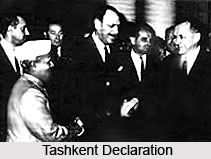The Prime Minister of India and the President of Pakistan, having met at Tashkent and having discussed the existing relations between India and Pakistan hereby declare their firms resolve to restore normal and peaceful relations between their countries and to promote understanding and friendly relations between their peoples. They consider the attainment of these objectives of vital importance for the welfare of the 600 million people of India and Pakistan.

•The Prime Minister of India and the President of Pakistan agree that both sides will exert all efforts to create good neighbourly relations between India and Pakistan in accordance with the United Nations Charter. They reaffirm their obligation under the Charter not to have recourse to force and to settle their disputes through peaceful means. They considered that the interests of peace in their region and particularly in the Indo-Pakistan sub-continent and, indeed, the interests of the people of India and Pakistan were not served by the continuance of tension between the two countries. It was against this background that Jammu and Kashmir was discussed, and each of the sides set forth its respective position.
•The Prime Minister of India and the President of Pakistan have agreed that all armed personnel of the two countries shall be withdrawn not later than 25 February 1966 to the positions they held prior to 5 August 1965, and both sides shall observe the cease-fire terms on the cease-fire line.
•The Prime Minister of India and the President of Pakistan have agreed that relations between India and Pakistan shall be based on the principle of non-interference in the internal affairs of each other.
•The Prime Minister of India and the President of Pakistan have agreed that both sides will discourage any propaganda directed against the other country and will encourage propaganda which promotes the development of friendly relations between the two countries.
•The Prime Minister of India and the President of Pakistan have agreed that High Commissioner of India to Pakistan and the High Commissioner of Pakistan to India will return to their posts and that the normal functioning of diplomatic missions of both countries will be restored. Both Governments shall observe the Vienna Convention of 1961 on Diplomatic Intercourse.
•The Prime Minister of India and the President of Pakistan have agreed to consider measures towards the restoration of economic and trade relations, communications as well as cultural exchanges between India and Pakistan, and to take measures to implement the existing agreements between India and Pakistan.
•The Prime Minister of India and the President of Pakistan have agreed that they will give instructions to their respective authorities to carry out the repatriation of the prisoners of war.
•The Prime Minister of India and the President of Pakistan have agreed that the two sides will continue the discussions of questions relating to the problems of refugees and evictions/illegal immigrations. They also agreed that both sides will create conditions which will prevent the exodus of people. They further agree to discuss the return of the property and assets taken over by either side in connection with the conflict.
•The Prime Minister of India and the President of Pakistan have agreed that the two sides will continue meetings both at highest and at other levels matters of direct concern to both countries. Both sides have recognized the need to set up joint Indian-Pakistani bodies, which will report to their Governments in order to decide what further steps should be taken.
The Prime Minister of India and the President of Pakistan record their feelings, deep appreciation and gratitude to the leaders of the Soviet Union, the Soviet Government and personally to the Chairman of the Council of Ministers of the USSR for their constructive, friendly and noble part in bringing about the present meeting which has resulted in mutually satisfactory results. They also express to the Government and friendly people of Uzbekistan their sincere thankfulness for their overwhelming reception and generous hospitality. They invite the Chairman of the Council of Ministers of the USSR to witness this declaration.



















